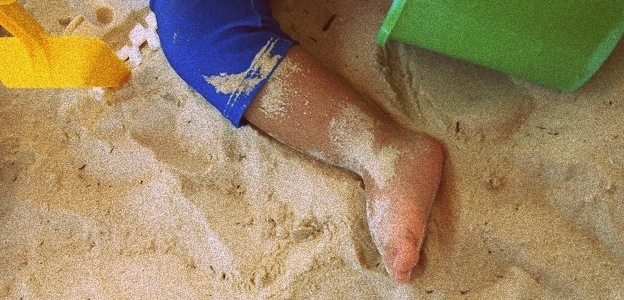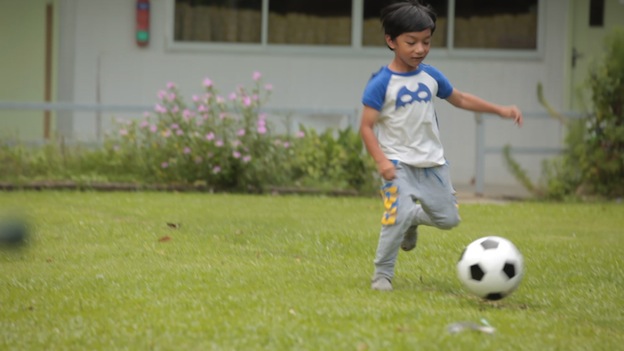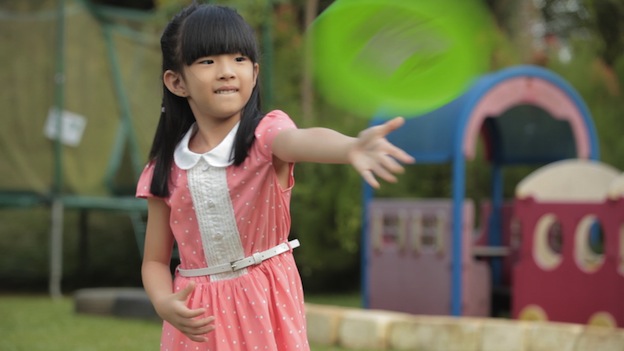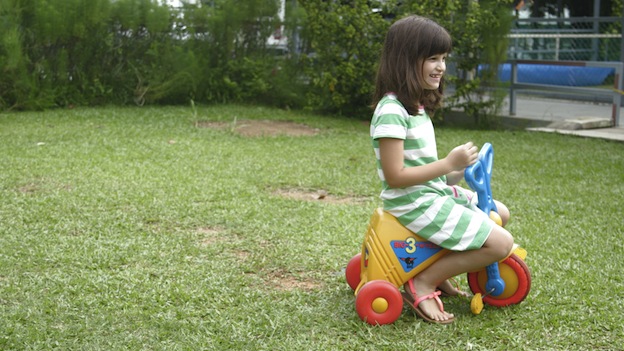SingaporeMotherhood | Parenting
September 2014
The Benefits of Active Play for Kids

On Sundays, merchandising executive Ifa Sani and her family often spend an entire afternoon at the beach where her three children aged six, nine, and 12 years race on their skate scooters, swim, or play badminton. “On weekends, my husband and I make it a point to take the kids outdoors to play. We allocate four hours on Saturday afternoons and four hours on Sunday afternoons for our children’s playtime,” says the 42-year-old, whose husband, 45, is self-employed.
To Ifa putting aside time for active play with her three children aged six, nine, and 12 years is important because of the benefits that physical activity. “My children have developed strong communication skills, outgoing personalities, and good social behaviour. They make friends very comfortably at the playground and at the beach!” she adds.
[banner][/banner]
Active play benefits extend beyond play areas and into the classrooms as well, Ifa has observed: “In school, they are able to concentrate in class and their performance are generally good. They are able focus and complete their homework.”
In a society where children’s lifestyles are becoming increasingly sedentary, the advantages of active play stand out. While Ifa has seen twice-weekly sessions of play boost her children’s abilities in and outdoors, experts recommend at least an hour of play a day. This standard is based on a study conducted by the US Department of Health and Human Services and has been adapted by several programmes worldwide.
Here in Singapore, Johnson’s Baby champions “60 minutes of Active Play a Day”. This campaign aims to spark conversation among parents and encourage them to include more play in their children’s lives.
What is Active Play?
Active play is any form of moderate to vigorous physical activity that elevates a child’s breathing and heart rate, and results in perspiration. Examples of moderate physical activities include leisure swimming and brisk walking, according to the Health Promotion Board (source). Examples of vigorous physical activities are playing “toss and catch” ball games, playing tag with friends, a competitive game of Frisbee – all of which require prolonged and/or intermittent bursts of physical exertion.
Active Play helps build a sharper mind through increased concentration and improved problem solving skills, which aids in better academic performance.
These benefits are supported by Dr Chong Shang Chee, Head of Child Development Unit of the National University Hospital. She tells us more about Active Play below.
Benefits of Active Play for children?
Active Play brings a host of benefits that extend beyond just developing a strong body:
Confidence and self‐esteem
Children are more sociable and are less prone to aggressive behaviours. They are also generally happier and calmer because physical exercise helps them relieve built‐up stress and frustration.
Better physical well‐being
There are lower levels of childhood obesity among active children, lower incidence of illnesses recorded, and fewer cases of myopia compared to their inactive peers. They develop stronger bones, toned muscles, as well as improved balance, hand‐eye coordination and movement skills.
Better quality sleep at night
This is crucial as the body continues to develop even during rest. Better sleep also makes children feel more energetic to take on challenges for the next day.
Most importantly, Active Play is proven to support building a sharper mind through increased concentration and heightened problem solving skills. For an academic setting, these qualities support the child’s ability to focus and perform better in class, as well as participate more actively in discussions and group work.
How much is required?
The HPB (Health Promotion Board) recommends 60 minutes of moderate to intense physical activity for primary school age children. For children below primary school age, HPB recommends 180 minutes of Active Play a day, consisting of varying intensity physical activities.
Examples of Active Play for children of primary school age include brisk walking, playing games such as ‘police and thief’, and competitive ball games such as soccer or basketball.
Examples of Active Play for younger children and babies below primary school age include walking instead of using a stroller, blowing bubbles and chasing after them, and playing ‘toss and catch’ ball games or ‘reach and grasp’ games.
Why outdoors?
The goal of Active Play is to elevate the child’s heartbeat and breathing, resulting in perspiration. Outdoor play allows children to inhale fresh air and exercise their sight by having to see objects near and far. Their interaction with the natural environment offers them a change of pace which helps to relieve the stress from the rigour of early childhood education, which many children are experiencing today. Playing outdoors during the day brings an added benefit of sun exposure which causes the body to produce vitamin D. This nutrient is important for building and maintaining strong bones.
How does Active Play contribute to a sharper mind in children?
Active Play improves the aerobic activity of the brain (in the form of blood flow and oxygenation), and this helps with learning and memory, both of which are crucial abilities required for academic performance. Active Play also increases neuronal activity that improves overall brain activity and hence learning. In addition, Active Play brings cardiovascular benefits and produces quality sleep in children – both of which contribute to better concentration in class during the day.
Active Play helps a child to regroup after prolonged concentration and sustained focus, through physical activity. It helps the child to return to his tasks in a better state of mind, and focus better.
Do parents have to do it as well?
Parents are encouraged to participate in Active Play as it sends a signal to children that this is an important event of the day, so that children will look forward to play sessions daily. In fact, parents play a pivotal role in cultivating and encouraging active play as a daily habit in children from young – this will help them to adopt regular Active Play as a healthy habit, so that they continue to enjoy the benefits of an active lifestyle when they grow up.
There are several ways parents can participate in Active Play. They may plan Active Play games with their children and serve as referees or game masters, or they can be participants in the games.
If the recommended hour(s) of active play a day is not possible every single day, what alternatives would you recommend?
This duration can be accumulated throughout the day; there is no need to commit an entire hour for Active Play. For instance, a child can have 30 minutes of Physical Education (PE) in school followed by 30 minutes of Active Play in the late afternoon. There are many forms of moderate intensity physical activities that can be considered Active Play, and some of which are basically daily activities, for example:
Brisk walking:
parents can walk their children home from school if home is within the vicinity, or alight one bus stop earlier and walk the rest of the journey home.
Climbing stairs:
at the MRT station, take the stairs to go up to the platform instead of using the escalator. If staying in high rise buildings, alight from the elevator a few stories below the apartment and climb the stairs for the rest of the way.
Images of children playing: Johnson’s Baby
#kidsthesedays
All content from this article, including images, cannot be reproduced without credits or written permission from SingaporeMotherhood.
Follow us on Facebook, Instagram, and Telegram for the latest article and promotion updates.








